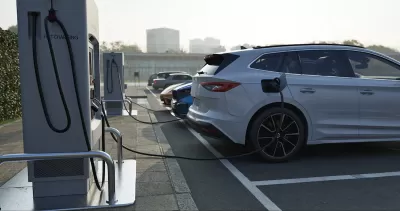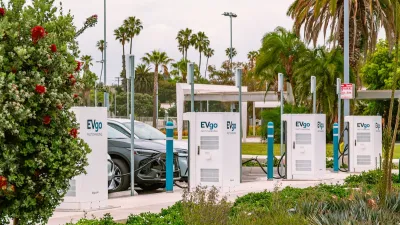The National Electric Vehicle Infrastructure program planned to fund the construction of hundreds of EV charging stations across the country.

The United States Department of Transportation (USDOT) has ordered all states to end their electric vehicle charging infrastructure programs, part of a $5 billion planned federal investment that would develop a nationwide system of EV charging stations to alleviate one of consumers’ main concerns, ‘range anxiety.’
As Aarian Marshall reports in Wired, “Officials at the Federal Highway Administration (FHWA), which manages the program, ordered state transportation directors to “decertify” the plans that all 50 states have used to outline where and how they will build their charging stations, and with what companies they’ll contract to do so.”
The program was designed to install chargers along major freeways and assist jurisdictions that may not be able to afford the cost.
Marshall notes that “The order may be illegal. It could fly in face of court orders demanding the Trump administration ‘unfreeze’ a funding pause that prevents federal money from flowing to state agencies. It may also violate the Administrative Procedures Act, which requires agencies to follow legal procedures before taking action.”
FULL STORY: Feds Halt the National Electric Vehicle Charging Program

Study: Maui’s Plan to Convert Vacation Rentals to Long-Term Housing Could Cause Nearly $1 Billion Economic Loss
The plan would reduce visitor accommodation by 25,% resulting in 1,900 jobs lost.

North Texas Transit Leaders Tout Benefits of TOD for Growing Region
At a summit focused on transit-oriented development, policymakers discussed how North Texas’ expanded light rail system can serve as a tool for economic growth.

Why Should We Subsidize Public Transportation?
Many public transit agencies face financial stress due to rising costs, declining fare revenue, and declining subsidies. Transit advocates must provide a strong business case for increasing public transit funding.

How to Make US Trains Faster
Changes to boarding platforms and a switch to electric trains could improve U.S. passenger rail service without the added cost of high-speed rail.

Columbia’s Revitalized ‘Loop’ Is a Hub for Local Entrepreneurs
A focus on small businesses is helping a commercial corridor in Columbia, Missouri thrive.

Invasive Insect Threatens Minnesota’s Ash Forests
The Emerald Ash Borer is a rapidly spreading invasive pest threatening Minnesota’s ash trees, and homeowners are encouraged to plant diverse replacement species, avoid moving ash firewood, and monitor for signs of infestation.
Urban Design for Planners 1: Software Tools
This six-course series explores essential urban design concepts using open source software and equips planners with the tools they need to participate fully in the urban design process.
Planning for Universal Design
Learn the tools for implementing Universal Design in planning regulations.
City of Santa Clarita
Ascent Environmental
Institute for Housing and Urban Development Studies (IHS)
City of Grandview
Harvard GSD Executive Education
Toledo-Lucas County Plan Commissions
Salt Lake City
NYU Wagner Graduate School of Public Service





























